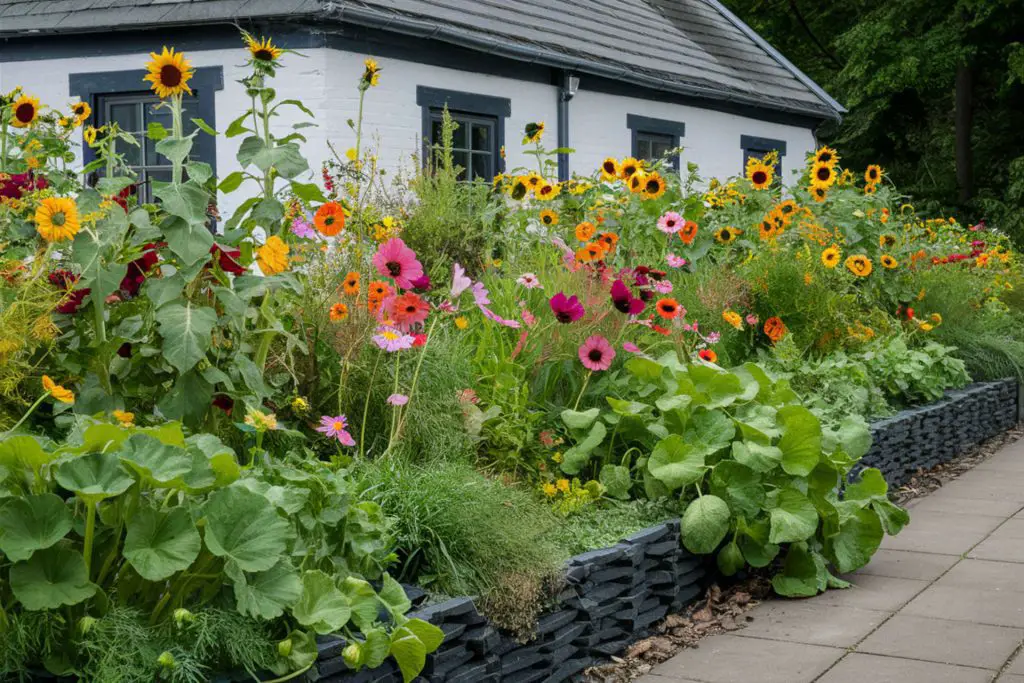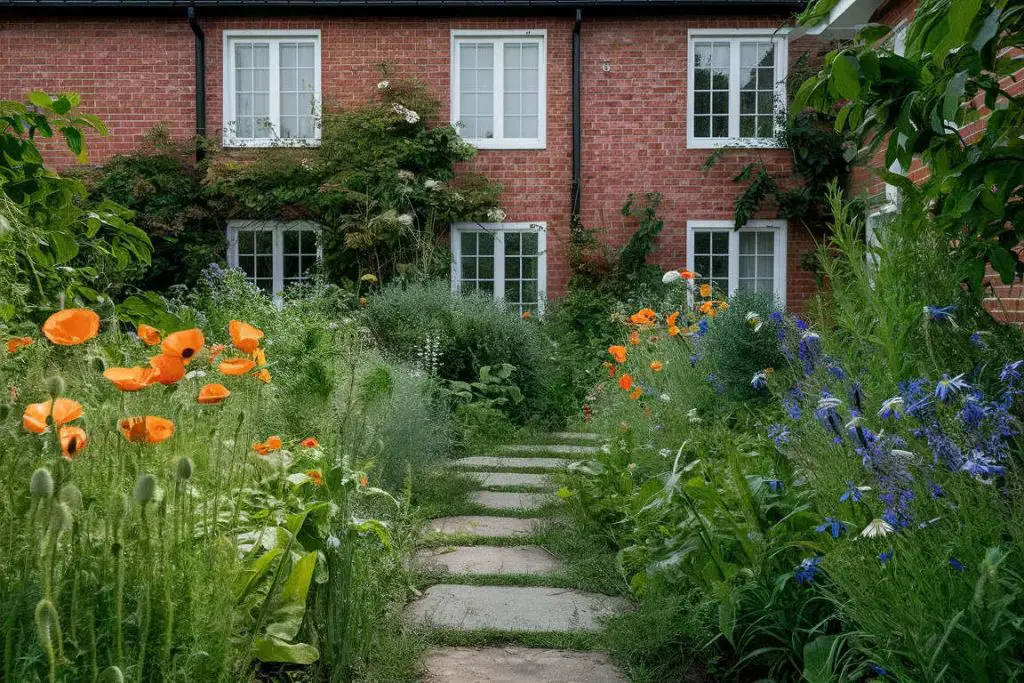Creating Elegant Chaos – Flower and Plant Combinations that Create Stunning Chaos Gardens
Gardening often invokes images of neat rows and perfectly aligned beds, but there’s a growing trend that celebrates the beauty in randomness: chaos gardening. This style embraces the natural disorder of wild gardens, allowing plants to grow where they may and creating a vibrant tapestry of life. Yet, within this wild charm lies the potential for an elegant form of chaos—carefully selected plant combinations that harmonize in their apparent disarray. Here are five planting combinations that bring an air of sophistication to the art of chaos gardening.
Sunflowers and Cosmos

Imagine stepping into a garden where towering sunflowers stand proudly like sentinels, their golden heads turned towards the sun. Interwoven among them, the delicate and feathery cosmos dance in the breeze, adding a sense of lightness and movement. This combination creates an atmosphere of joyful spontaneity, evoking the carefree beauty of a wildflower meadow. It’s a scene that feels both vibrant and serene, inviting you to pause and enjoy the simple pleasures of nature.
Planting Details
Tall, striking sunflowers provide a bold backdrop, while delicate, airy cosmos weave through their sturdy stems. The contrasting shapes and colors create a dynamic, eye-catching display that balances structure with whimsy.
Lavender and Echinacea

Picture a garden corner filled with the soothing scent of lavender, its soft purple spikes swaying gently. Amongst this calming sea, echinacea’s bold and spiky blooms stand out, adding a pop of color and texture. The mix of these plants conjures an atmosphere of tranquility and vitality, perfect for a relaxing retreat. The combination encourages a sense of well-being, blending the peacefulness of lavender with the invigorating presence of echinacea.
Planting Details
The soothing hues of lavender paired with the spiky, vibrant blooms of echinacea offer a visually appealing and fragrant combination. The differing heights and textures enhance the garden’s layered look.
Nasturtiums and Sweet Alyssum

Visualize a garden bed where vibrant nasturtiums cascade gracefully, their bright flowers spilling over edges and weaving through other plants. Below them, sweet alyssum forms a fragrant, cloud-like carpet of tiny white blooms. This pairing creates an enchanting atmosphere of abundant charm, where the richness of colors and sweet scents invite you to linger and explore. It’s a setting that feels cozy and welcoming, perfect for a cottage garden or an intimate outdoor space.
Planting Details
Nasturtiums’ trailing vines and vibrant flowers mix effortlessly with the low-growing, fragrant clusters of sweet alyssum. This pairing thrives in both ground cover and cascading arrangements, adding depth and interest.
Foxgloves and Daisies

Step into a garden where the stately foxgloves reach skyward, their bell-shaped flowers adding height and elegance. Below, a cheerful array of daisies spreads out, their sunny faces turning upward. This combination crafts an atmosphere of timeless grace and joy, reminiscent of a classic English garden. The interplay of tall and short, formal and informal, brings a balanced yet dynamic feel, inviting both contemplation and delight.
Planting Details
Tall, elegant foxgloves rise above a sea of cheerful daisies, creating a lovely vertical contrast. The interplay of height and the daisies’ bright faces adds a touch of grace to the seemingly wild arrangement.
Poppies and Cornflowers

Envision a garden bed alive with the soft, silky petals of poppies fluttering like delicate silk in the breeze, paired with the bold, brilliant blue of cornflowers. This pairing creates a striking and harmonious contrast, evoking an atmosphere of artistic beauty. The colors and forms meld to create a scene that feels both spontaneous and thoughtfully composed, perfect for a garden that aims to surprise and delight at every turn.
Planting Details
The soft, delicate petals of poppies contrast beautifully with the striking blue of cornflowers. Their complementary colors and varied textures bring a harmonious yet untamed feel to any garden bed.
Tips for Pairing Plants to Create the Chaos Look
Creating a garden that appears wild yet refined is an art form that embraces nature’s inherent disorder while maintaining a touch of elegance. This approach, often referred to as chaos gardening, celebrates the beauty of spontaneous growth and diverse plant combinations. To master this style, consider these tips for pairing plants effectively. By thoughtfully selecting and arranging your plants, you can achieve a harmonious blend that captures the charm of nature’s unpredictability without sacrificing visual appeal. Here are some guidelines to help you cultivate an elegantly chaotic garden.
- Choose Varied Heights and Textures: Mixing plants of different heights and textures adds depth and interest to your garden. Tall plants like sunflowers or foxgloves can serve as anchors, while lower-growing flowers like sweet alyssum or daisies fill in gaps and create a lush, layered effect.
- Embrace a Broad Color Palette: Don’t be afraid to play with colors. Combining contrasting hues, such as the bold yellows of sunflowers with the soft pinks of cosmos, creates a vibrant, eye-catching display. Similarly, the striking blue of cornflowers against the warm tones of poppies adds visual excitement.
- Allow for Natural Spread: Choose plants that can naturally weave through each other without overwhelming the space. Trailing plants like nasturtiums can create a cascading effect, while more upright plants like echinacea add structure without crowding.
- Mix Bloom Times: Ensure that your garden maintains its charm throughout the growing season by selecting plants with varying bloom times. Early bloomers like poppies can provide initial bursts of color, followed by mid-season stars like daisies and late bloomers like lavender.
- Consider Foliage and Form: Flowers are important, but so is foliage. Pair plants with different leaf shapes and colors to add another layer of interest. For example, the silvery foliage of lavender contrasts beautifully with the green, spiky leaves of echinacea.
- Use Native Plants: Native plants often require less maintenance and can thrive in local conditions, making them ideal for a more natural, chaotic look. They also support local wildlife, adding another layer of life and movement to your garden.
- Plant Densely: A dense planting scheme reduces the likelihood of weeds taking over and creates a fuller, more cohesive look. This approach mimics the wild growth patterns found in nature, enhancing the chaotic aesthetic.
- Include Self-Seeding Varieties: Plants that self-seed, like cosmos and poppies, can perpetuate the chaos year after year, filling in gaps and adding an element of surprise as they pop up in new spots each season.
Final Thoughts
Embracing the chaos gardening style can transform your garden into a vibrant, dynamic space that feels both natural and thoughtfully curated. By pairing plants with varied heights, textures, and bloom times, you create a living tapestry that evolves throughout the season. Remember to allow for natural growth patterns, choose plants that complement each other, and consider the overall aesthetic you want to achieve. With a bit of planning and a touch of spontaneity, your garden can become a beautiful blend of wild charm and elegant design.
